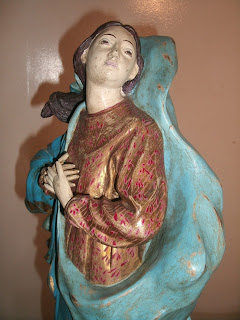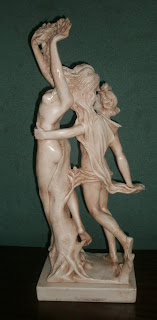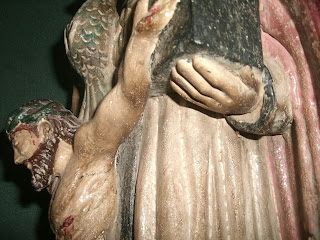Carved and painted
wood.
Sculpture:- 61cm
high x 28cm wide x 14cm deep
Base :- 21cm high x
24cm wide x 28cm deep
Signed. “ G T Nepo
”
Circa :- early
1900's
Description.
This is beautiful
version of “ Our Lady of the Assumption” by Nepomuceno, depicts
Our Lady looking up serenely into the heavens, knowing She is going
home to Her Son.
Her hands are both
clasped to Her chest not in prayer but more in adoration of Her God.
While striking this
pose Her left heal is on the head of the serpent.
Genesis 3 : 15 “
And I will put enmity between you and the woman, and between your
offspring and hers; he will crush your head, and you will strike his
heel."
Our Lady is dressed
in a gold dress with flecks of red on it. The dress is round necked,
long sleeves and is caught around the waist with a gold sash.
Her cape is draped
over Her right shoulder and is wrapped right around Her body.
It is interesting
how the cape is carved so the inside can be seen as well, especially
on the left side and around Her back and it is being blown up behind
Her head as she is rising up to heaven. The cape is trimmed with
gold.
She has no head
covering and Her hair is being blown over Her right shoulder.
She is standing on a
cloud as she rises up to heaven. Her feet are bare and be seen
protruding from under Her dress as she stands on the cloud.
The snake can also
be seen under Her dress, its head coming out from beneath Her left
foot, it has a red apple in its mouth. Its body can be seen under the
dress on the left side and its tail can be seen coming out behind Her
right foot.
The base is in the
shape of a cloud with three Angels looking out, the three have brown
hair and wings.
The base stands on
another base that is six sided and painted dark brown.
Distinguishing
marks.
The sculpture and the top of the cloud are one piece of wood, the
join is on the middle of the cloud and the bottom of the cloud and
six sided base are one piece of wood.
The sculpture is in excellent condition, all fingers and toes are
accounted for and the face has no damage.
The paint is in good condition considering the age of the piece.
The cloud is painted pale blue and the six sided lower base is brown.
The sculpture is signed on the back right side, below the tail of the
snake, “G T Nepo”
This is a very nice sculpture By Nepomuceno, taking religious Art
into Fine Art Sculpture.
Written by,
Mark Shellshear
Art consultant.

















































